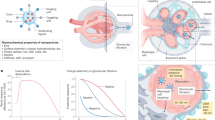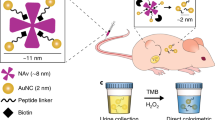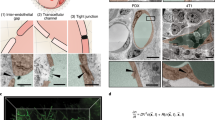Abstract
The glomerular filtration barrier is known as a ‘size cutoff’ slit, which retains nanoparticles or proteins larger than 6–8 nm in the body and rapidly excretes smaller ones through the kidneys. However, in the sub-nanometre size regime, we have found that this barrier behaves as an atomically precise ‘bandpass’ filter to significantly slow down renal clearance of few-atom gold nanoclusters (AuNCs) with the same surface ligands but different sizes (Au18, Au15 and Au10-11). Compared to Au25 (∼1.0 nm), just few-atom decreases in size result in four- to ninefold reductions in renal clearance efficiency in the early elimination stage, because the smaller AuNCs are more readily trapped by the glomerular glycocalyx than larger ones. This unique in vivo nano–bio interaction in the sub-nanometre regime also slows down the extravasation of sub-nanometre AuNCs from normal blood vessels and enhances their passive targeting to cancerous tissues through an enhanced permeability and retention effect. This discovery highlights the size precision in the body's response to nanoparticles and opens a new pathway to develop nanomedicines for many diseases associated with glycocalyx dysfunction.
This is a preview of subscription content, access via your institution
Access options
Access Nature and 54 other Nature Portfolio journals
Get Nature+, our best-value online-access subscription
$29.99 / 30 days
cancel any time
Subscribe to this journal
Receive 12 print issues and online access
$259.00 per year
only $21.58 per issue
Buy this article
- Purchase on Springer Link
- Instant access to full article PDF
Prices may be subject to local taxes which are calculated during checkout




Similar content being viewed by others
References
Ohta, S., Glancy, D. & Chan, W. C. DNA-controlled dynamic colloidal nanoparticle systems for mediating cellular interaction. Science 351, 841–845 (2016).
Shi, J., Kantoff, P. W., Wooster, R. & Farokhzad, O. C. Cancer nanomedicine: progress, challenges and opportunities. Nat. Rev. Cancer 17, 20–37 (2017).
Albanese, A., Tang, P. S. & Chan, W. C. The effect of nanoparticle size, shape, and surface chemistry on biological systems. Annu. Rev. Biomed. Eng. 14, 1–16 (2012).
Chithrani, B. D., Ghazani, A. A. & Chan, W. C. Determining the size and shape dependence of gold nanoparticle uptake into mammalian cells. Nano Lett. 6, 662–668 (2006).
Sykes, E. A., Chen, J., Zheng, G. & Chan, W. C. Investigating the impact of nanoparticle size on active and passive tumor targeting efficiency. ACS Nano 8, 5696–5706 (2014).
Huang, K. et al. Size-dependent localization and penetration of ultrasmall gold nanoparticles in cancer cells, multicellular spheroids, and tumors in vivo. ACS Nano 6, 4483–4493 (2012).
Wang, B., He, X., Zhang, Z., Zhao, Y. & Feng, W. Metabolism of nanomaterials in vivo: blood circulation and organ clearance. Acc. Chem. Res. 46, 761–769 (2013).
Yu, M. & Zheng, J. Clearance pathways and tumor targeting of imaging nanoparticles. ACS Nano 9, 6655–6674 (2015).
Blanco, E., Shen, H. & Ferrari, M. Principles of nanoparticle design for overcoming biological barriers to drug delivery. Nat. Biotechnol. 33, 941–951 (2015).
Longmire, M., Choyke, P. L. & Kobayashi, H. Clearance properties of nano-sized particles and molecules as imaging agents: considerations and caveats. Nanomedicine (Lond.) 3, 703–717 (2008).
Ye, L. et al. A pilot study in non-human primates shows no adverse response to intravenous injection of quantum dots. Nat. Nanotech. 7, 453–458 (2012).
Haraldsson, B., Nyström, J. & Deen, W. M. Properties of the glomerular barrier and mechanisms of proteinuria. Physiol. Rev. 88, 451–487 (2008).
Hall, J. E. Guyton and Hall Textbook of Medical Physiology (Elsevier Health Sciences, 2015).
Choi, H. S. et al. Renal clearance of quantum dots. Nat. Biotechnol. 25, 1165–1170 (2007).
Burns, A. A. et al. Fluorescent silica nanoparticles with efficient urinary excretion for nanomedicine. Nano Lett. 9, 442–448 (2009).
Zhou, C. et al. Near-infrared emitting radioactive gold nanoparticles with molecular pharmacokinetics. Angew. Chem. Int. Ed. 124, 10265–10269 (2012).
Zhou, C., Long, M., Qin, Y., Sun, X. & Zheng, J. Luminescent gold nanoparticles with efficient renal clearance. Angew. Chem. Int. Ed. 123, 3226–3230 (2011).
Venturoli, D. & Rippe, B. Ficoll and dextran vs. globular proteins as probes for testing glomerular permselectivity: effects of molecular size, shape, charge, and deformability. Am. J. Physiol. Renal Physiol. 288, F605–F613 (2004).
Rennke, H. G., Cotran, R. S. & Venkatachalam, M. A. Role of molecular charge in glomerular permeability. Tracer studies with cationized ferritins. J. Cell Biol. 67, 638–646 (1975).
Azubel, M. et al. Electron microscopy of gold nanoparticles at atomic resolution. Science 345, 909–912 (2014).
Li, G., Jiang, D.-e., Kumar, S., Chen, Y. & Jin, R. Size dependence of atomically precise gold nanoclusters in chemoselective hydrogenation and active site structure. ACS Catal. 4, 2463–2469 (2014).
Jadzinsky, P. D., Calero, G., Ackerson, C. J., Bushnell, D. A. & Kornberg, R. D. Structure of a thiol monolayer-protected gold nanoparticle at 1.1 Å resolution. Science 318, 430–433 (2007).
Zheng, J., Petty, J. T. & Dickson, R. M. High quantum yield blue emission from water-soluble Au8 nanodots. J. Am. Chem. Soc. 125, 7780–7781 (2003).
Jin, R., Zeng, C., Zhou, M. & Chen, Y. Atomically precise colloidal metal nanoclusters and nanoparticles: fundamentals and opportunities. Chem. Rev. 116, 10346–10413 (2016).
Tang, S. et al. Tailoring renal clearance and tumor targeting of ultrasmall metal nanoparticles with particle density. Angew. Chem. Int. Ed. 128, 16273–16277 (2016).
Liu, J. et al. Passive tumor targeting of renal-clearable luminescent gold nanoparticles: long tumor retention and fast normal tissue clearance. J. Am. Chem. Soc. 135, 4978–4981 (2013).
Singh, A. & Satchell, S. C. Microalbuminuria: causes and implications. Pediatr. Nephrol. 26, 1957–1965 (2011).
Chou, L. Y., Fischer, H. C., Perrault, S. D. & Chan, W. C. Visualizing quantum dots in biological samples using silver staining. Anal. Chem. 81, 4560–4565 (2009).
Vernier, R. L., Steffes, M. W., Sisson-Ross, S. & Mauer, S. M. Heparan sulfate proteoglycan in the glomerular basement membrane in type 1 diabetes mellitus. Kidney Int. 41, 1070–1080 (1992).
Rubinson, K. A. & Rubinson, J. F. Contemporary Instrumental Analysis (Prentice Hall, 2000).
Uhl, B. et al. The endothelial glycocalyx controls interactions of quantum dots with the endothelium and their translocation across the blood–tissue border. ACS Nano 11, 1498–1508 (2017).
Nieuwdorp, M. et al. The endothelial glycocalyx: a potential barrier between health and vascular disease. Curr. Opin. Lipidol. 16, 507–511 (2005).
Greenblatt, D. J. Elimination half-life of drugs: value and limitations. Annu. Rev. Med. 36, 421–427 (1985).
Fang, J., Nakamura, H. & Maeda, H. The EPR effect: unique features of tumor blood vessels for drug delivery, factors involved, and limitations and augmentation of the effect. Adv. Drug Del. Rev. 63, 136–151 (2011).
Liu, J. et al. PEGylation and zwitterionization: pros and cons in the renal clearance and tumor targeting of near-IR-emitting gold nanoparticles. Angew. Chem. Int Ed. 125, 12804–12808 (2013).
Kang, H. et al. Renal clearable organic nanocarriers for bioimaging and drug delivery. Adv. Mater. 28, 8162–8168 (2016).
Yu, Y. et al. Scalable and precise synthesis of thiolated Au10–12, Au15, Au18, and Au25 nanoclusters via pH controlled CO reduction. Chem. Mater. 25, 946–952 (2013).
Yao, Q. et al. Two-phase synthesis of small thiolate-protected Au15 and Au18 nanoclusters. Small 9, 2696–2701 (2013).
Shichibu, Y., Negishi, Y., Tsukuda, T. & Teranishi, T. Large-scale synthesis of thiolated Au25 clusters via ligand exchange reactions of phosphine-stabilized Au11 clusters. J. Am. Chem. Soc. 127, 13464–13465 (2005).
Das, A. et al. Total structure and optical properties of a phosphine/thiolate-protected Au24 nanocluster. J. Am. Chem. Soc. 134, 20286–20289 (2012).
Negishi, Y., Nobusada, K. & Tsukuda, T. Glutathione-protected gold clusters revisited: bridging the gap between gold(I)–thiolate complexes and thiolate-protected gold nanocrystals. J. Am. Chem. Soc. 127, 5261–5270 (2005).
Yu, Y. et al. Identification of a highly luminescent Au22(SG)18 nanocluster. J. Am. Chem. Soc. 136, 1246–1249 (2014).
Acknowledgements
This study was in part supported by the NIH (1R01DK103363), CPRIT (RP140544) and a start-up fund from the University of Texas at Dallas (to J.Z.).
Author information
Authors and Affiliations
Contributions
J.Z. conceived the idea and designed experiments with B.D. and R.J. B.D. performed in vivo experiments and analysed data with J.Z. X.J., Q.Z. and A.D. synthesized AuNCs. X.J. and M.Y. assisted with the in vivo experiment. J.Z. and B.D. wrote the manuscript. J.Z. supervised the project. All authors discussed the results and commented on the manuscript.
Corresponding author
Ethics declarations
Competing interests
The authors declare no competing financial interests.
Supplementary information
Supplementary information
Supplementary information (PDF 14889 kb)
Supplementary information
Supplementary Movie 1 (MP4 578 kb)
Supplementary information
Supplementary Movie 2 (MP4 2250 kb)
Supplementary information
Supplementary Movie 3 (MP4 3263 kb)
Rights and permissions
About this article
Cite this article
Du, B., Jiang, X., Das, A. et al. Glomerular barrier behaves as an atomically precise bandpass filter in a sub-nanometre regime. Nature Nanotech 12, 1096–1102 (2017). https://doi.org/10.1038/nnano.2017.170
Received:
Accepted:
Published:
Issue Date:
DOI: https://doi.org/10.1038/nnano.2017.170
This article is cited by
-
Atomically precise photothermal nanomachines
Nature Materials (2024)
-
Physiological principles underlying the kidney targeting of renal nanomedicines
Nature Reviews Nephrology (2024)
-
Artificial urinary biomarker probes for diagnosis
Nature Reviews Bioengineering (2024)
-
Breaking through the basement membrane barrier to improve nanotherapeutic delivery to tumours
Nature Nanotechnology (2024)
-
Biological Interaction and Imaging of Ultrasmall Gold Nanoparticles
Nano-Micro Letters (2024)



